Applied Business Finance: Financial Ratios and Business Review
VerifiedAdded on 2023/06/14
|13
|2663
|383
Report
AI Summary
This report provides a comprehensive analysis of applied business finance, focusing on financial statement analysis, ratio calculations, and business structure. It begins by explaining the concept and importance of financial management, emphasizing its role in budgeting, resource allocation, and maximizing profitability. The report then describes key financial statements, including the balance sheet, income statement, and cash flow statement, along with the use of financial ratios in assessing a company's financial health. A business review template is completed, and financial statements are produced using Excel. The report calculates liquidity, profitability, and efficiency ratios to evaluate the company's performance. Finally, it describes the structure of the business and suggests ways to improve company performance, such as personnel leadership, promotional advertising, and capital investment evaluation. The analysis concludes that effective financial management is crucial for accurate assessment and improvement of an organization's financial standing.
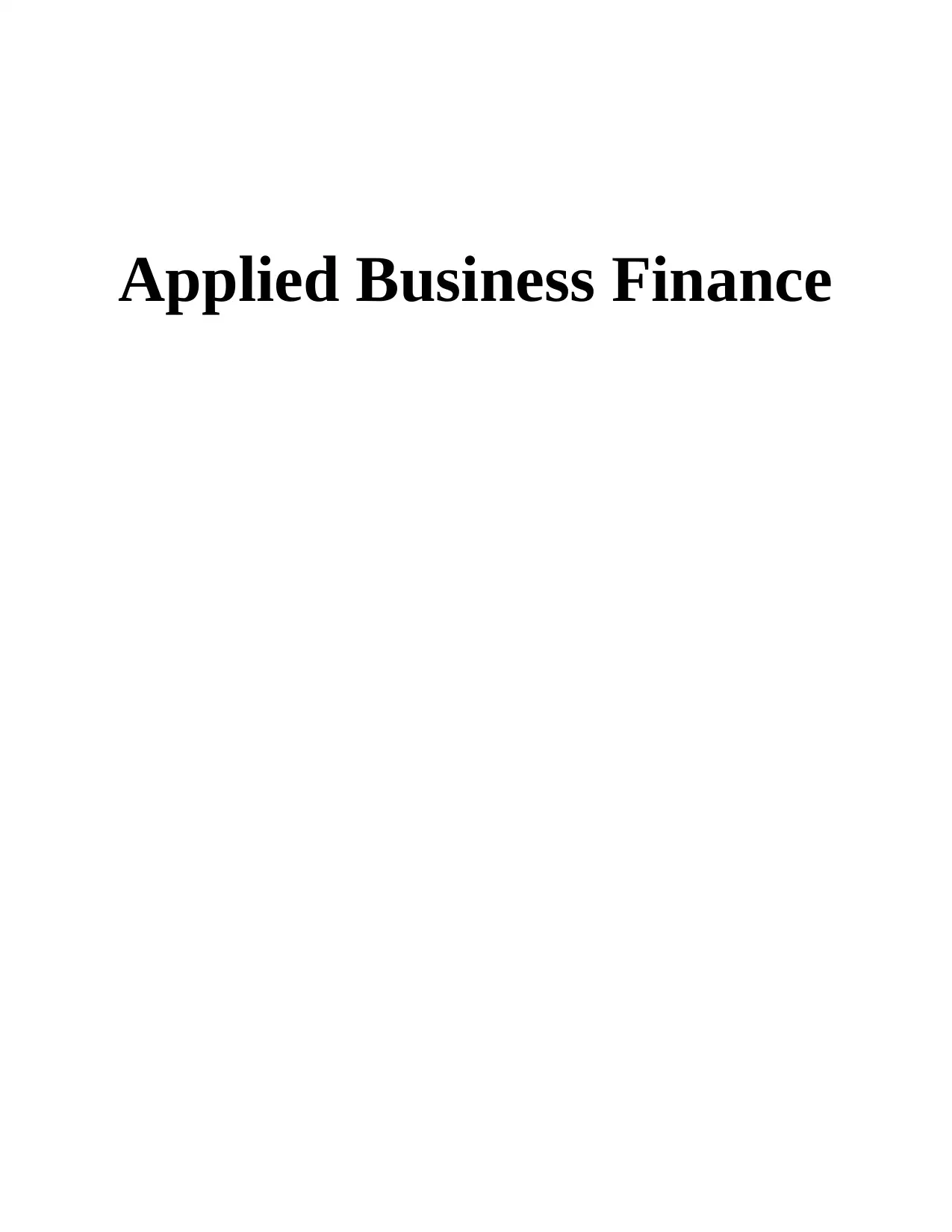
Applied Business Finance
Paraphrase This Document
Need a fresh take? Get an instant paraphrase of this document with our AI Paraphraser

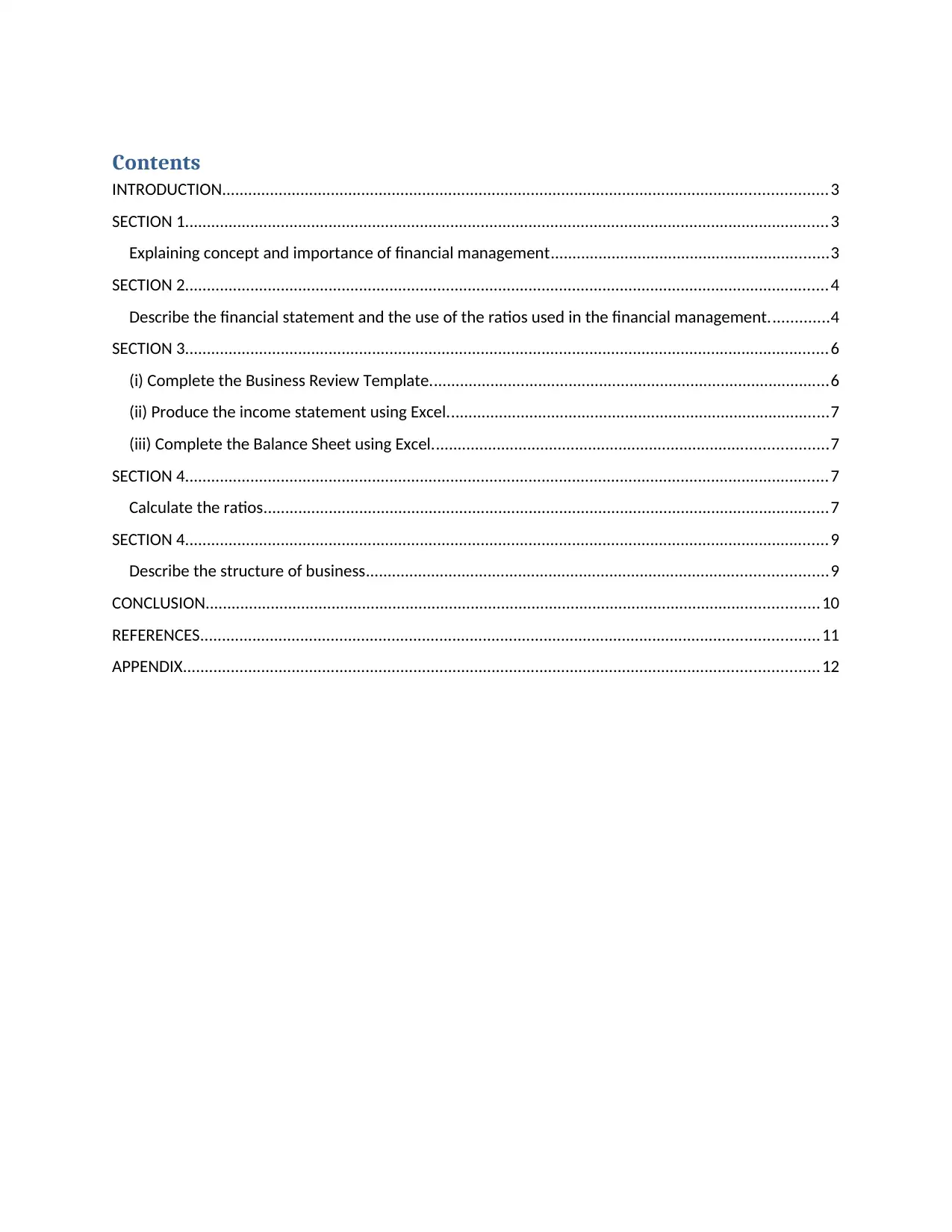
Contents
INTRODUCTION...........................................................................................................................................3
SECTION 1....................................................................................................................................................3
Explaining concept and importance of financial management................................................................3
SECTION 2....................................................................................................................................................4
Describe the financial statement and the use of the ratios used in the financial management..............4
SECTION 3....................................................................................................................................................6
(i) Complete the Business Review Template............................................................................................6
(ii) Produce the income statement using Excel........................................................................................7
(iii) Complete the Balance Sheet using Excel...........................................................................................7
SECTION 4....................................................................................................................................................7
Calculate the ratios..................................................................................................................................7
SECTION 4....................................................................................................................................................9
Describe the structure of business..........................................................................................................9
CONCLUSION.............................................................................................................................................10
REFERENCES..............................................................................................................................................11
APPENDIX..................................................................................................................................................12
INTRODUCTION...........................................................................................................................................3
SECTION 1....................................................................................................................................................3
Explaining concept and importance of financial management................................................................3
SECTION 2....................................................................................................................................................4
Describe the financial statement and the use of the ratios used in the financial management..............4
SECTION 3....................................................................................................................................................6
(i) Complete the Business Review Template............................................................................................6
(ii) Produce the income statement using Excel........................................................................................7
(iii) Complete the Balance Sheet using Excel...........................................................................................7
SECTION 4....................................................................................................................................................7
Calculate the ratios..................................................................................................................................7
SECTION 4....................................................................................................................................................9
Describe the structure of business..........................................................................................................9
CONCLUSION.............................................................................................................................................10
REFERENCES..............................................................................................................................................11
APPENDIX..................................................................................................................................................12
⊘ This is a preview!⊘
Do you want full access?
Subscribe today to unlock all pages.

Trusted by 1+ million students worldwide
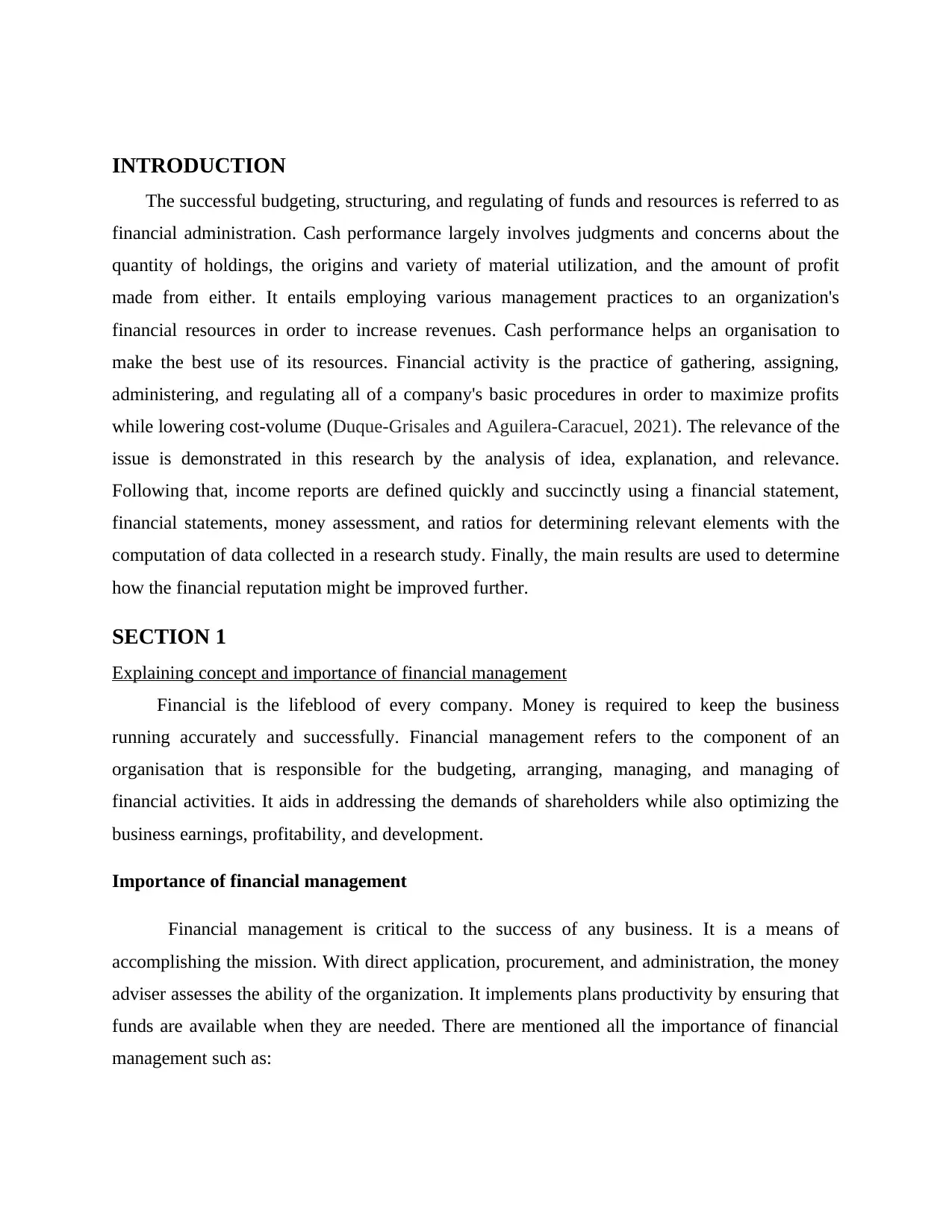
INTRODUCTION
The successful budgeting, structuring, and regulating of funds and resources is referred to as
financial administration. Cash performance largely involves judgments and concerns about the
quantity of holdings, the origins and variety of material utilization, and the amount of profit
made from either. It entails employing various management practices to an organization's
financial resources in order to increase revenues. Cash performance helps an organisation to
make the best use of its resources. Financial activity is the practice of gathering, assigning,
administering, and regulating all of a company's basic procedures in order to maximize profits
while lowering cost-volume (Duque-Grisales and Aguilera-Caracuel, 2021). The relevance of the
issue is demonstrated in this research by the analysis of idea, explanation, and relevance.
Following that, income reports are defined quickly and succinctly using a financial statement,
financial statements, money assessment, and ratios for determining relevant elements with the
computation of data collected in a research study. Finally, the main results are used to determine
how the financial reputation might be improved further.
SECTION 1
Explaining concept and importance of financial management
Financial is the lifeblood of every company. Money is required to keep the business
running accurately and successfully. Financial management refers to the component of an
organisation that is responsible for the budgeting, arranging, managing, and managing of
financial activities. It aids in addressing the demands of shareholders while also optimizing the
business earnings, profitability, and development.
Importance of financial management
Financial management is critical to the success of any business. It is a means of
accomplishing the mission. With direct application, procurement, and administration, the money
adviser assesses the ability of the organization. It implements plans productivity by ensuring that
funds are available when they are needed. There are mentioned all the importance of financial
management such as:
The successful budgeting, structuring, and regulating of funds and resources is referred to as
financial administration. Cash performance largely involves judgments and concerns about the
quantity of holdings, the origins and variety of material utilization, and the amount of profit
made from either. It entails employing various management practices to an organization's
financial resources in order to increase revenues. Cash performance helps an organisation to
make the best use of its resources. Financial activity is the practice of gathering, assigning,
administering, and regulating all of a company's basic procedures in order to maximize profits
while lowering cost-volume (Duque-Grisales and Aguilera-Caracuel, 2021). The relevance of the
issue is demonstrated in this research by the analysis of idea, explanation, and relevance.
Following that, income reports are defined quickly and succinctly using a financial statement,
financial statements, money assessment, and ratios for determining relevant elements with the
computation of data collected in a research study. Finally, the main results are used to determine
how the financial reputation might be improved further.
SECTION 1
Explaining concept and importance of financial management
Financial is the lifeblood of every company. Money is required to keep the business
running accurately and successfully. Financial management refers to the component of an
organisation that is responsible for the budgeting, arranging, managing, and managing of
financial activities. It aids in addressing the demands of shareholders while also optimizing the
business earnings, profitability, and development.
Importance of financial management
Financial management is critical to the success of any business. It is a means of
accomplishing the mission. With direct application, procurement, and administration, the money
adviser assesses the ability of the organization. It implements plans productivity by ensuring that
funds are available when they are needed. There are mentioned all the importance of financial
management such as:
Paraphrase This Document
Need a fresh take? Get an instant paraphrase of this document with our AI Paraphraser
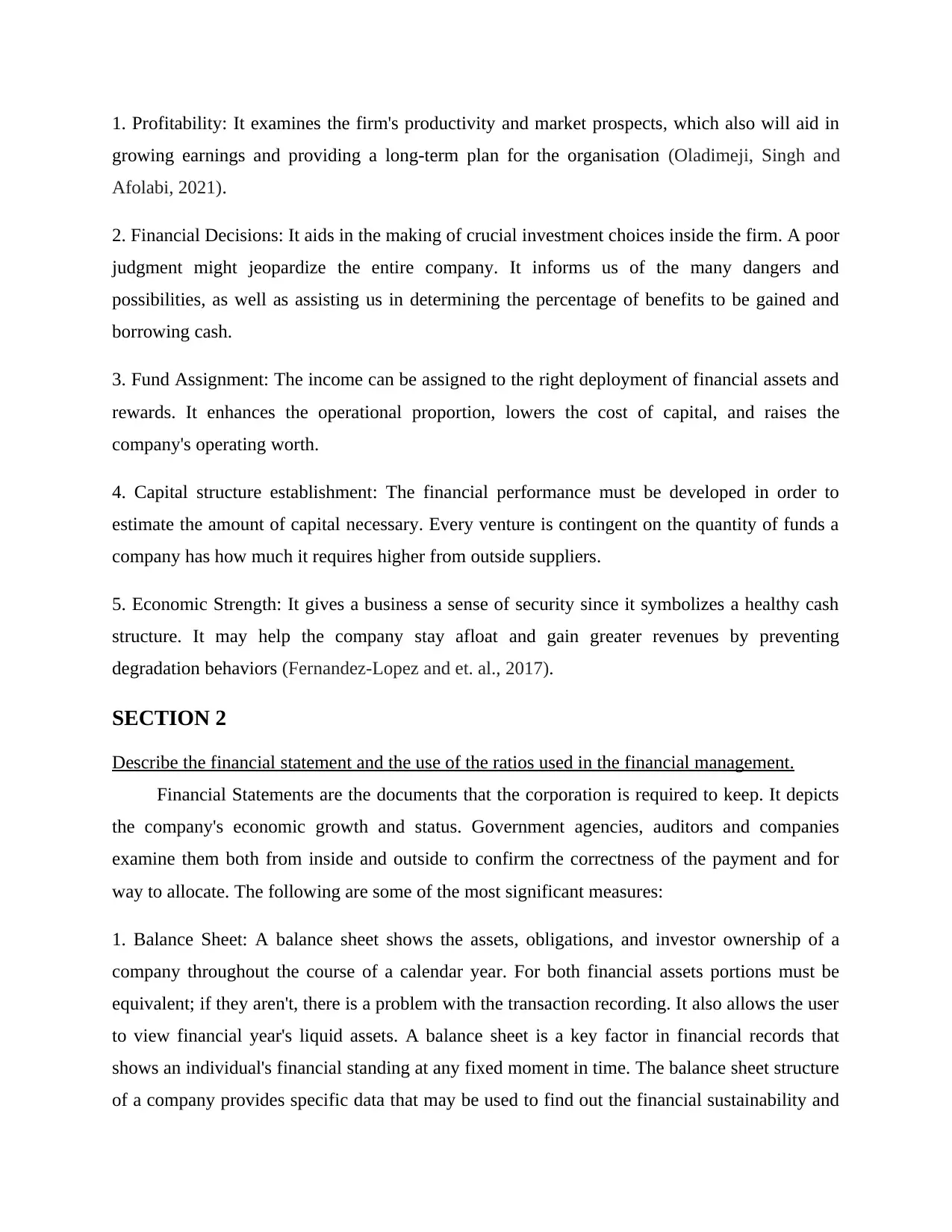
1. Profitability: It examines the firm's productivity and market prospects, which also will aid in
growing earnings and providing a long-term plan for the organisation (Oladimeji, Singh and
Afolabi, 2021).
2. Financial Decisions: It aids in the making of crucial investment choices inside the firm. A poor
judgment might jeopardize the entire company. It informs us of the many dangers and
possibilities, as well as assisting us in determining the percentage of benefits to be gained and
borrowing cash.
3. Fund Assignment: The income can be assigned to the right deployment of financial assets and
rewards. It enhances the operational proportion, lowers the cost of capital, and raises the
company's operating worth.
4. Capital structure establishment: The financial performance must be developed in order to
estimate the amount of capital necessary. Every venture is contingent on the quantity of funds a
company has how much it requires higher from outside suppliers.
5. Economic Strength: It gives a business a sense of security since it symbolizes a healthy cash
structure. It may help the company stay afloat and gain greater revenues by preventing
degradation behaviors (Fernandez-Lopez and et. al., 2017).
SECTION 2
Describe the financial statement and the use of the ratios used in the financial management.
Financial Statements are the documents that the corporation is required to keep. It depicts
the company's economic growth and status. Government agencies, auditors and companies
examine them both from inside and outside to confirm the correctness of the payment and for
way to allocate. The following are some of the most significant measures:
1. Balance Sheet: A balance sheet shows the assets, obligations, and investor ownership of a
company throughout the course of a calendar year. For both financial assets portions must be
equivalent; if they aren't, there is a problem with the transaction recording. It also allows the user
to view financial year's liquid assets. A balance sheet is a key factor in financial records that
shows an individual's financial standing at any fixed moment in time. The balance sheet structure
of a company provides specific data that may be used to find out the financial sustainability and
growing earnings and providing a long-term plan for the organisation (Oladimeji, Singh and
Afolabi, 2021).
2. Financial Decisions: It aids in the making of crucial investment choices inside the firm. A poor
judgment might jeopardize the entire company. It informs us of the many dangers and
possibilities, as well as assisting us in determining the percentage of benefits to be gained and
borrowing cash.
3. Fund Assignment: The income can be assigned to the right deployment of financial assets and
rewards. It enhances the operational proportion, lowers the cost of capital, and raises the
company's operating worth.
4. Capital structure establishment: The financial performance must be developed in order to
estimate the amount of capital necessary. Every venture is contingent on the quantity of funds a
company has how much it requires higher from outside suppliers.
5. Economic Strength: It gives a business a sense of security since it symbolizes a healthy cash
structure. It may help the company stay afloat and gain greater revenues by preventing
degradation behaviors (Fernandez-Lopez and et. al., 2017).
SECTION 2
Describe the financial statement and the use of the ratios used in the financial management.
Financial Statements are the documents that the corporation is required to keep. It depicts
the company's economic growth and status. Government agencies, auditors and companies
examine them both from inside and outside to confirm the correctness of the payment and for
way to allocate. The following are some of the most significant measures:
1. Balance Sheet: A balance sheet shows the assets, obligations, and investor ownership of a
company throughout the course of a calendar year. For both financial assets portions must be
equivalent; if they aren't, there is a problem with the transaction recording. It also allows the user
to view financial year's liquid assets. A balance sheet is a key factor in financial records that
shows an individual's financial standing at any fixed moment in time. The balance sheet structure
of a company provides specific data that may be used to find out the financial sustainability and
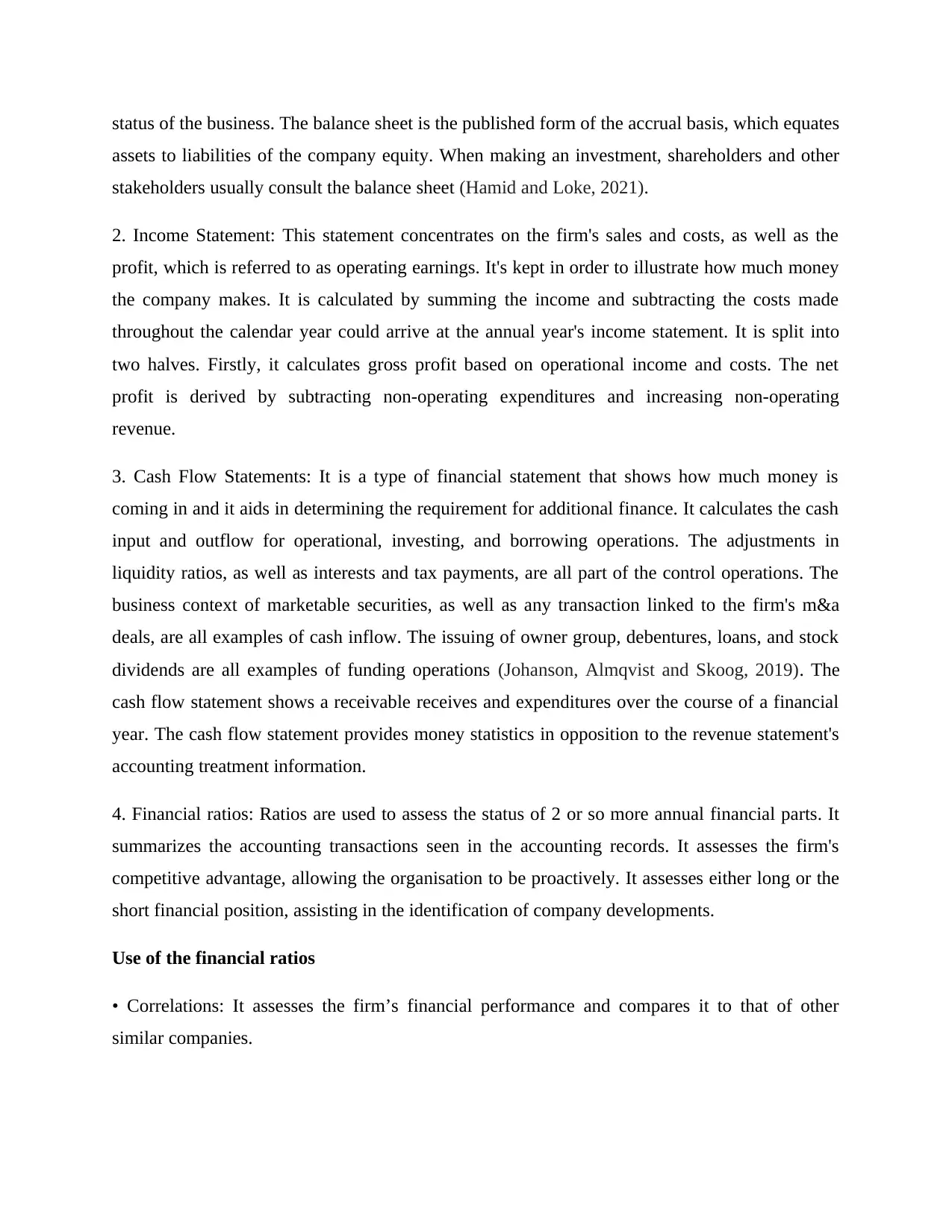
status of the business. The balance sheet is the published form of the accrual basis, which equates
assets to liabilities of the company equity. When making an investment, shareholders and other
stakeholders usually consult the balance sheet (Hamid and Loke, 2021).
2. Income Statement: This statement concentrates on the firm's sales and costs, as well as the
profit, which is referred to as operating earnings. It's kept in order to illustrate how much money
the company makes. It is calculated by summing the income and subtracting the costs made
throughout the calendar year could arrive at the annual year's income statement. It is split into
two halves. Firstly, it calculates gross profit based on operational income and costs. The net
profit is derived by subtracting non-operating expenditures and increasing non-operating
revenue.
3. Cash Flow Statements: It is a type of financial statement that shows how much money is
coming in and it aids in determining the requirement for additional finance. It calculates the cash
input and outflow for operational, investing, and borrowing operations. The adjustments in
liquidity ratios, as well as interests and tax payments, are all part of the control operations. The
business context of marketable securities, as well as any transaction linked to the firm's m&a
deals, are all examples of cash inflow. The issuing of owner group, debentures, loans, and stock
dividends are all examples of funding operations (Johanson, Almqvist and Skoog, 2019). The
cash flow statement shows a receivable receives and expenditures over the course of a financial
year. The cash flow statement provides money statistics in opposition to the revenue statement's
accounting treatment information.
4. Financial ratios: Ratios are used to assess the status of 2 or so more annual financial parts. It
summarizes the accounting transactions seen in the accounting records. It assesses the firm's
competitive advantage, allowing the organisation to be proactively. It assesses either long or the
short financial position, assisting in the identification of company developments.
Use of the financial ratios
• Correlations: It assesses the firm’s financial performance and compares it to that of other
similar companies.
assets to liabilities of the company equity. When making an investment, shareholders and other
stakeholders usually consult the balance sheet (Hamid and Loke, 2021).
2. Income Statement: This statement concentrates on the firm's sales and costs, as well as the
profit, which is referred to as operating earnings. It's kept in order to illustrate how much money
the company makes. It is calculated by summing the income and subtracting the costs made
throughout the calendar year could arrive at the annual year's income statement. It is split into
two halves. Firstly, it calculates gross profit based on operational income and costs. The net
profit is derived by subtracting non-operating expenditures and increasing non-operating
revenue.
3. Cash Flow Statements: It is a type of financial statement that shows how much money is
coming in and it aids in determining the requirement for additional finance. It calculates the cash
input and outflow for operational, investing, and borrowing operations. The adjustments in
liquidity ratios, as well as interests and tax payments, are all part of the control operations. The
business context of marketable securities, as well as any transaction linked to the firm's m&a
deals, are all examples of cash inflow. The issuing of owner group, debentures, loans, and stock
dividends are all examples of funding operations (Johanson, Almqvist and Skoog, 2019). The
cash flow statement shows a receivable receives and expenditures over the course of a financial
year. The cash flow statement provides money statistics in opposition to the revenue statement's
accounting treatment information.
4. Financial ratios: Ratios are used to assess the status of 2 or so more annual financial parts. It
summarizes the accounting transactions seen in the accounting records. It assesses the firm's
competitive advantage, allowing the organisation to be proactively. It assesses either long or the
short financial position, assisting in the identification of company developments.
Use of the financial ratios
• Correlations: It assesses the firm’s financial performance and compares it to that of other
similar companies.
⊘ This is a preview!⊘
Do you want full access?
Subscribe today to unlock all pages.

Trusted by 1+ million students worldwide
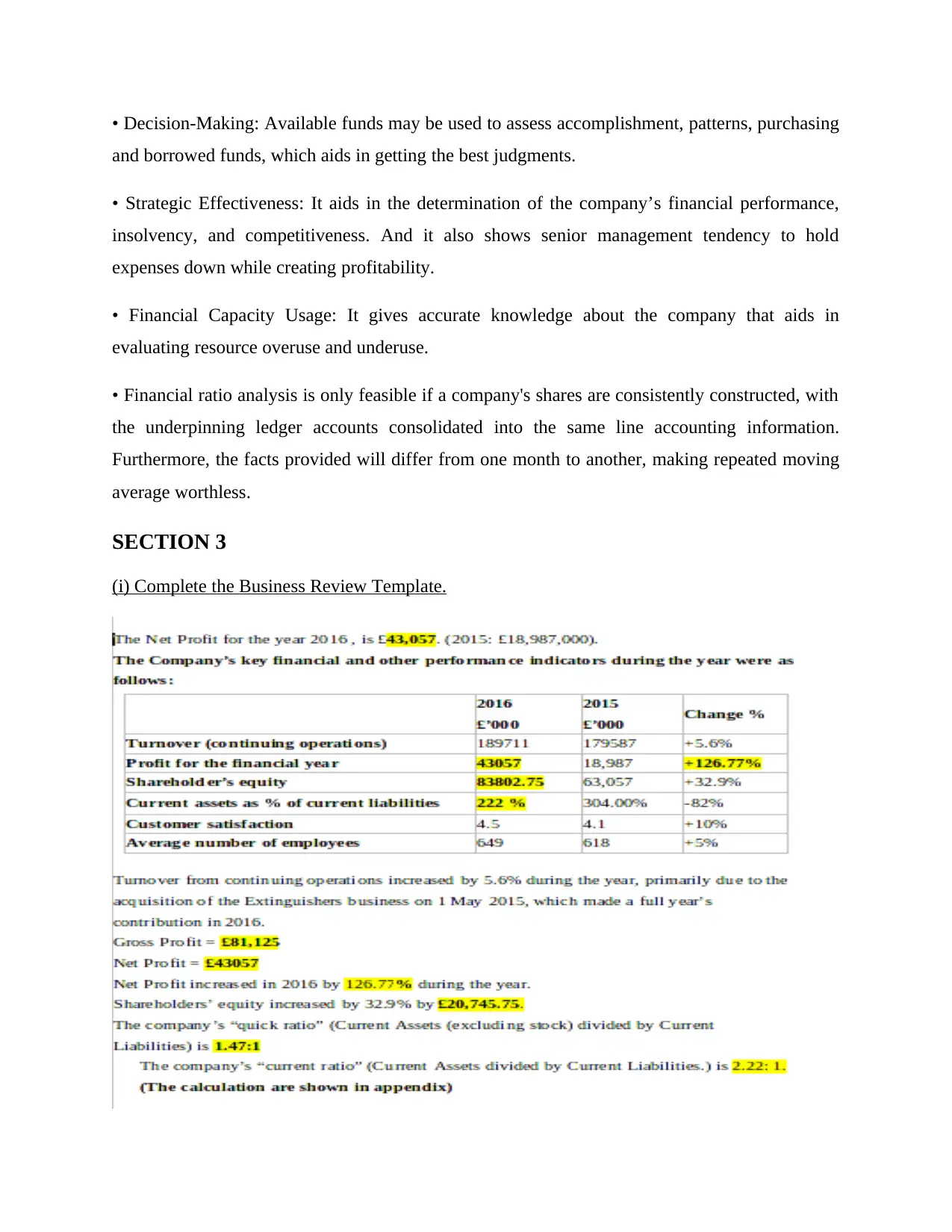
• Decision-Making: Available funds may be used to assess accomplishment, patterns, purchasing
and borrowed funds, which aids in getting the best judgments.
• Strategic Effectiveness: It aids in the determination of the company’s financial performance,
insolvency, and competitiveness. And it also shows senior management tendency to hold
expenses down while creating profitability.
• Financial Capacity Usage: It gives accurate knowledge about the company that aids in
evaluating resource overuse and underuse.
• Financial ratio analysis is only feasible if a company's shares are consistently constructed, with
the underpinning ledger accounts consolidated into the same line accounting information.
Furthermore, the facts provided will differ from one month to another, making repeated moving
average worthless.
SECTION 3
(i) Complete the Business Review Template.
and borrowed funds, which aids in getting the best judgments.
• Strategic Effectiveness: It aids in the determination of the company’s financial performance,
insolvency, and competitiveness. And it also shows senior management tendency to hold
expenses down while creating profitability.
• Financial Capacity Usage: It gives accurate knowledge about the company that aids in
evaluating resource overuse and underuse.
• Financial ratio analysis is only feasible if a company's shares are consistently constructed, with
the underpinning ledger accounts consolidated into the same line accounting information.
Furthermore, the facts provided will differ from one month to another, making repeated moving
average worthless.
SECTION 3
(i) Complete the Business Review Template.
Paraphrase This Document
Need a fresh take? Get an instant paraphrase of this document with our AI Paraphraser
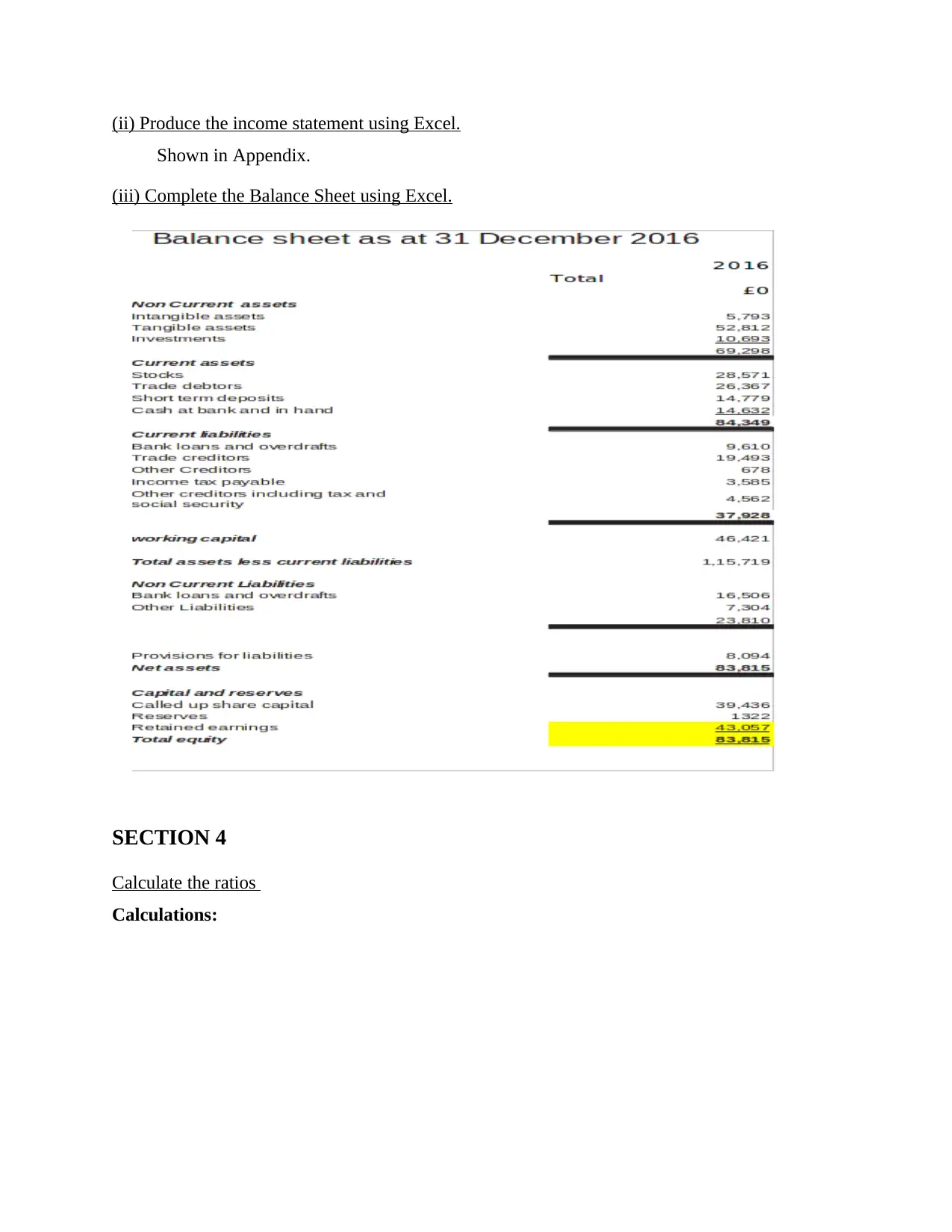
(ii) Produce the income statement using Excel.
Shown in Appendix.
(iii) Complete the Balance Sheet using Excel.
SECTION 4
Calculate the ratios
Calculations:
Shown in Appendix.
(iii) Complete the Balance Sheet using Excel.
SECTION 4
Calculate the ratios
Calculations:
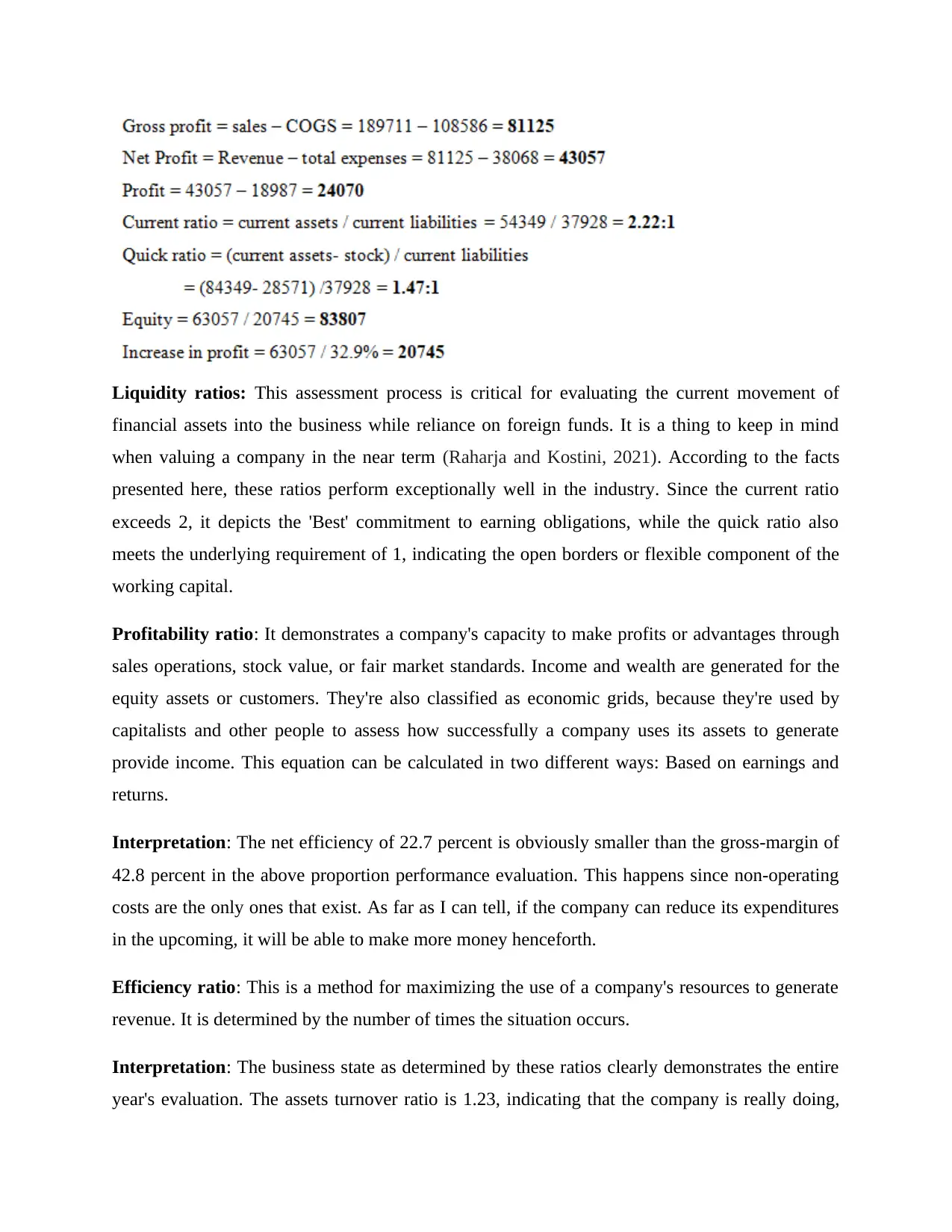
Liquidity ratios: This assessment process is critical for evaluating the current movement of
financial assets into the business while reliance on foreign funds. It is a thing to keep in mind
when valuing a company in the near term (Raharja and Kostini, 2021). According to the facts
presented here, these ratios perform exceptionally well in the industry. Since the current ratio
exceeds 2, it depicts the 'Best' commitment to earning obligations, while the quick ratio also
meets the underlying requirement of 1, indicating the open borders or flexible component of the
working capital.
Profitability ratio: It demonstrates a company's capacity to make profits or advantages through
sales operations, stock value, or fair market standards. Income and wealth are generated for the
equity assets or customers. They're also classified as economic grids, because they're used by
capitalists and other people to assess how successfully a company uses its assets to generate
provide income. This equation can be calculated in two different ways: Based on earnings and
returns.
Interpretation: The net efficiency of 22.7 percent is obviously smaller than the gross-margin of
42.8 percent in the above proportion performance evaluation. This happens since non-operating
costs are the only ones that exist. As far as I can tell, if the company can reduce its expenditures
in the upcoming, it will be able to make more money henceforth.
Efficiency ratio: This is a method for maximizing the use of a company's resources to generate
revenue. It is determined by the number of times the situation occurs.
Interpretation: The business state as determined by these ratios clearly demonstrates the entire
year's evaluation. The assets turnover ratio is 1.23, indicating that the company is really doing,
financial assets into the business while reliance on foreign funds. It is a thing to keep in mind
when valuing a company in the near term (Raharja and Kostini, 2021). According to the facts
presented here, these ratios perform exceptionally well in the industry. Since the current ratio
exceeds 2, it depicts the 'Best' commitment to earning obligations, while the quick ratio also
meets the underlying requirement of 1, indicating the open borders or flexible component of the
working capital.
Profitability ratio: It demonstrates a company's capacity to make profits or advantages through
sales operations, stock value, or fair market standards. Income and wealth are generated for the
equity assets or customers. They're also classified as economic grids, because they're used by
capitalists and other people to assess how successfully a company uses its assets to generate
provide income. This equation can be calculated in two different ways: Based on earnings and
returns.
Interpretation: The net efficiency of 22.7 percent is obviously smaller than the gross-margin of
42.8 percent in the above proportion performance evaluation. This happens since non-operating
costs are the only ones that exist. As far as I can tell, if the company can reduce its expenditures
in the upcoming, it will be able to make more money henceforth.
Efficiency ratio: This is a method for maximizing the use of a company's resources to generate
revenue. It is determined by the number of times the situation occurs.
Interpretation: The business state as determined by these ratios clearly demonstrates the entire
year's evaluation. The assets turnover ratio is 1.23, indicating that the company is really doing,
⊘ This is a preview!⊘
Do you want full access?
Subscribe today to unlock all pages.

Trusted by 1+ million students worldwide
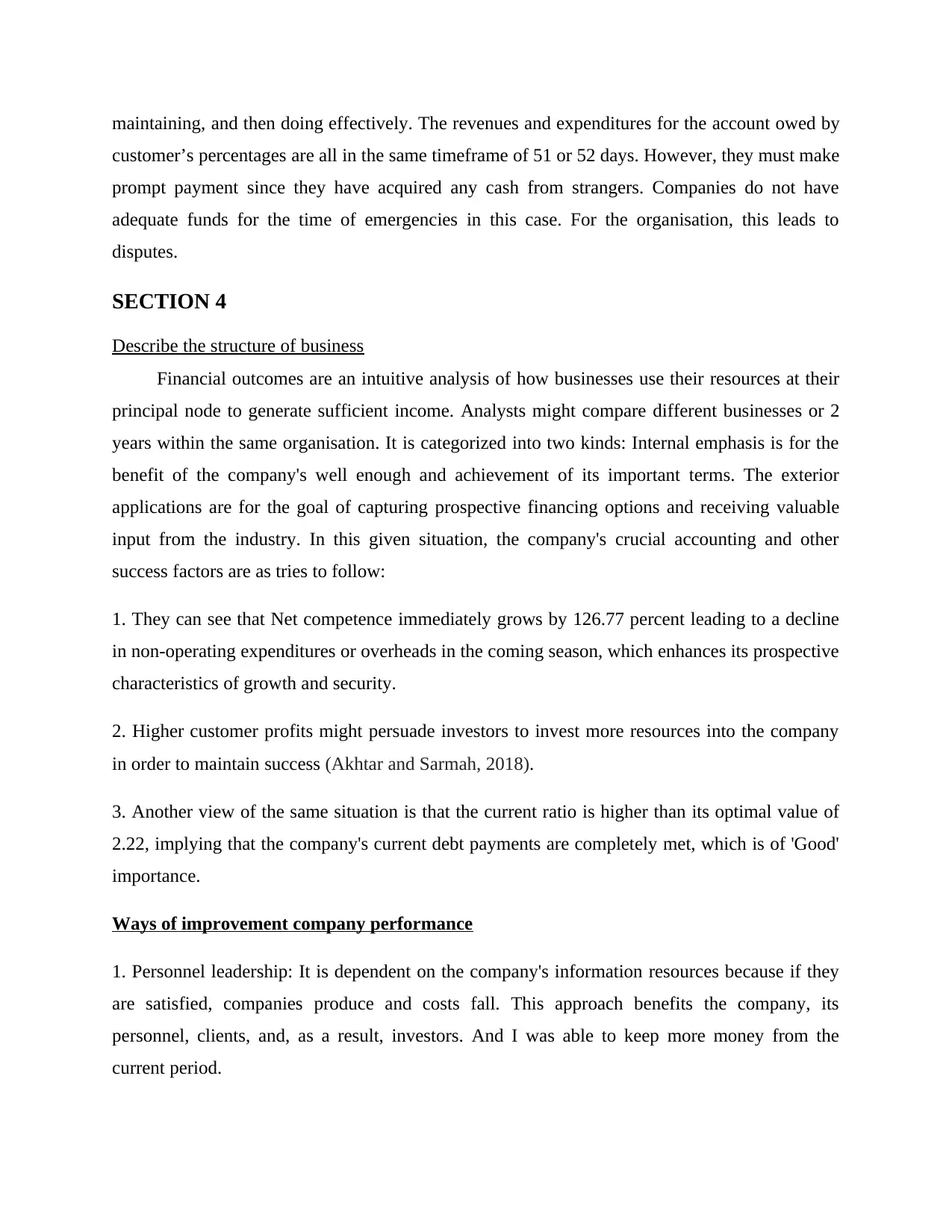
maintaining, and then doing effectively. The revenues and expenditures for the account owed by
customer’s percentages are all in the same timeframe of 51 or 52 days. However, they must make
prompt payment since they have acquired any cash from strangers. Companies do not have
adequate funds for the time of emergencies in this case. For the organisation, this leads to
disputes.
SECTION 4
Describe the structure of business
Financial outcomes are an intuitive analysis of how businesses use their resources at their
principal node to generate sufficient income. Analysts might compare different businesses or 2
years within the same organisation. It is categorized into two kinds: Internal emphasis is for the
benefit of the company's well enough and achievement of its important terms. The exterior
applications are for the goal of capturing prospective financing options and receiving valuable
input from the industry. In this given situation, the company's crucial accounting and other
success factors are as tries to follow:
1. They can see that Net competence immediately grows by 126.77 percent leading to a decline
in non-operating expenditures or overheads in the coming season, which enhances its prospective
characteristics of growth and security.
2. Higher customer profits might persuade investors to invest more resources into the company
in order to maintain success (Akhtar and Sarmah, 2018).
3. Another view of the same situation is that the current ratio is higher than its optimal value of
2.22, implying that the company's current debt payments are completely met, which is of 'Good'
importance.
Ways of improvement company performance
1. Personnel leadership: It is dependent on the company's information resources because if they
are satisfied, companies produce and costs fall. This approach benefits the company, its
personnel, clients, and, as a result, investors. And I was able to keep more money from the
current period.
customer’s percentages are all in the same timeframe of 51 or 52 days. However, they must make
prompt payment since they have acquired any cash from strangers. Companies do not have
adequate funds for the time of emergencies in this case. For the organisation, this leads to
disputes.
SECTION 4
Describe the structure of business
Financial outcomes are an intuitive analysis of how businesses use their resources at their
principal node to generate sufficient income. Analysts might compare different businesses or 2
years within the same organisation. It is categorized into two kinds: Internal emphasis is for the
benefit of the company's well enough and achievement of its important terms. The exterior
applications are for the goal of capturing prospective financing options and receiving valuable
input from the industry. In this given situation, the company's crucial accounting and other
success factors are as tries to follow:
1. They can see that Net competence immediately grows by 126.77 percent leading to a decline
in non-operating expenditures or overheads in the coming season, which enhances its prospective
characteristics of growth and security.
2. Higher customer profits might persuade investors to invest more resources into the company
in order to maintain success (Akhtar and Sarmah, 2018).
3. Another view of the same situation is that the current ratio is higher than its optimal value of
2.22, implying that the company's current debt payments are completely met, which is of 'Good'
importance.
Ways of improvement company performance
1. Personnel leadership: It is dependent on the company's information resources because if they
are satisfied, companies produce and costs fall. This approach benefits the company, its
personnel, clients, and, as a result, investors. And I was able to keep more money from the
current period.
Paraphrase This Document
Need a fresh take? Get an instant paraphrase of this document with our AI Paraphraser
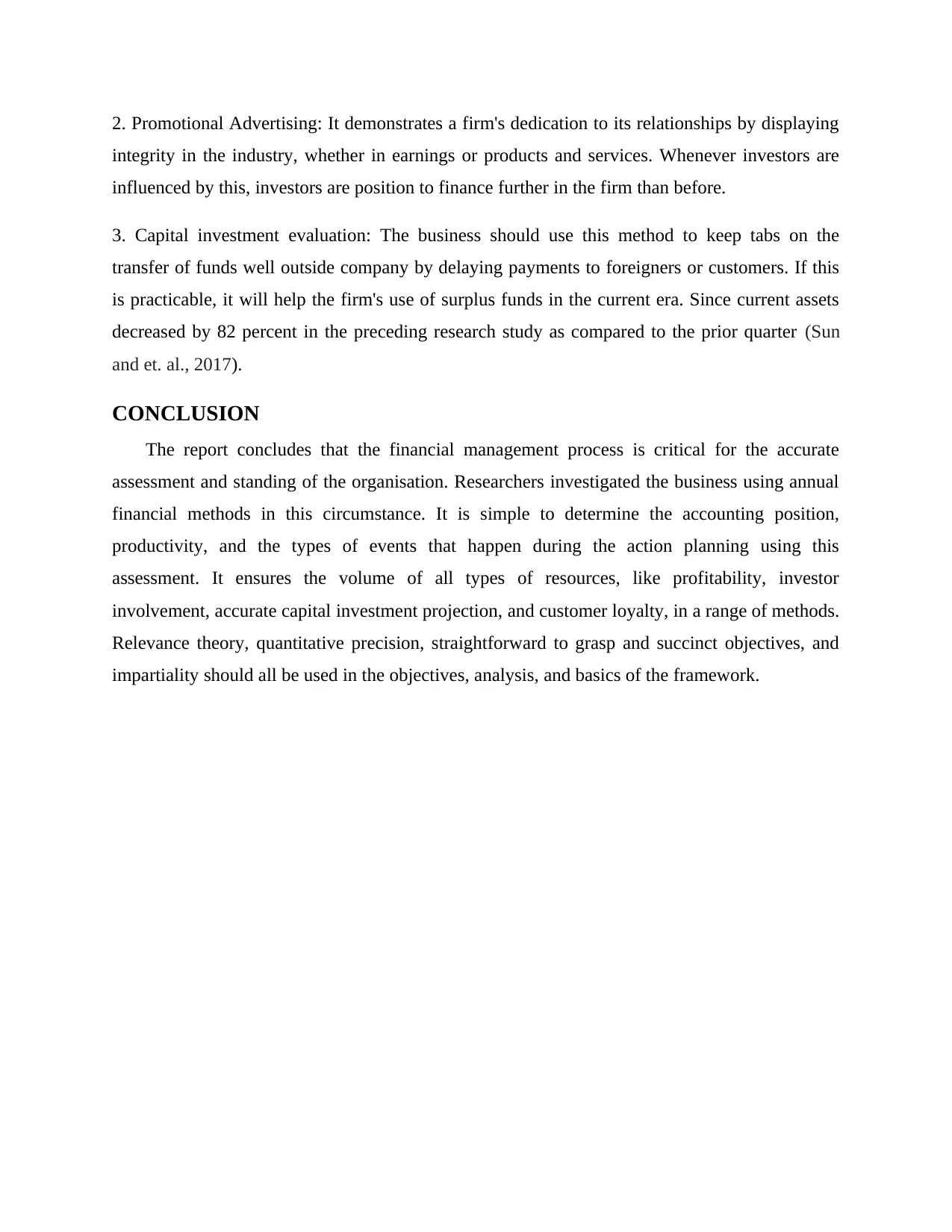
2. Promotional Advertising: It demonstrates a firm's dedication to its relationships by displaying
integrity in the industry, whether in earnings or products and services. Whenever investors are
influenced by this, investors are position to finance further in the firm than before.
3. Capital investment evaluation: The business should use this method to keep tabs on the
transfer of funds well outside company by delaying payments to foreigners or customers. If this
is practicable, it will help the firm's use of surplus funds in the current era. Since current assets
decreased by 82 percent in the preceding research study as compared to the prior quarter (Sun
and et. al., 2017).
CONCLUSION
The report concludes that the financial management process is critical for the accurate
assessment and standing of the organisation. Researchers investigated the business using annual
financial methods in this circumstance. It is simple to determine the accounting position,
productivity, and the types of events that happen during the action planning using this
assessment. It ensures the volume of all types of resources, like profitability, investor
involvement, accurate capital investment projection, and customer loyalty, in a range of methods.
Relevance theory, quantitative precision, straightforward to grasp and succinct objectives, and
impartiality should all be used in the objectives, analysis, and basics of the framework.
integrity in the industry, whether in earnings or products and services. Whenever investors are
influenced by this, investors are position to finance further in the firm than before.
3. Capital investment evaluation: The business should use this method to keep tabs on the
transfer of funds well outside company by delaying payments to foreigners or customers. If this
is practicable, it will help the firm's use of surplus funds in the current era. Since current assets
decreased by 82 percent in the preceding research study as compared to the prior quarter (Sun
and et. al., 2017).
CONCLUSION
The report concludes that the financial management process is critical for the accurate
assessment and standing of the organisation. Researchers investigated the business using annual
financial methods in this circumstance. It is simple to determine the accounting position,
productivity, and the types of events that happen during the action planning using this
assessment. It ensures the volume of all types of resources, like profitability, investor
involvement, accurate capital investment projection, and customer loyalty, in a range of methods.
Relevance theory, quantitative precision, straightforward to grasp and succinct objectives, and
impartiality should all be used in the objectives, analysis, and basics of the framework.
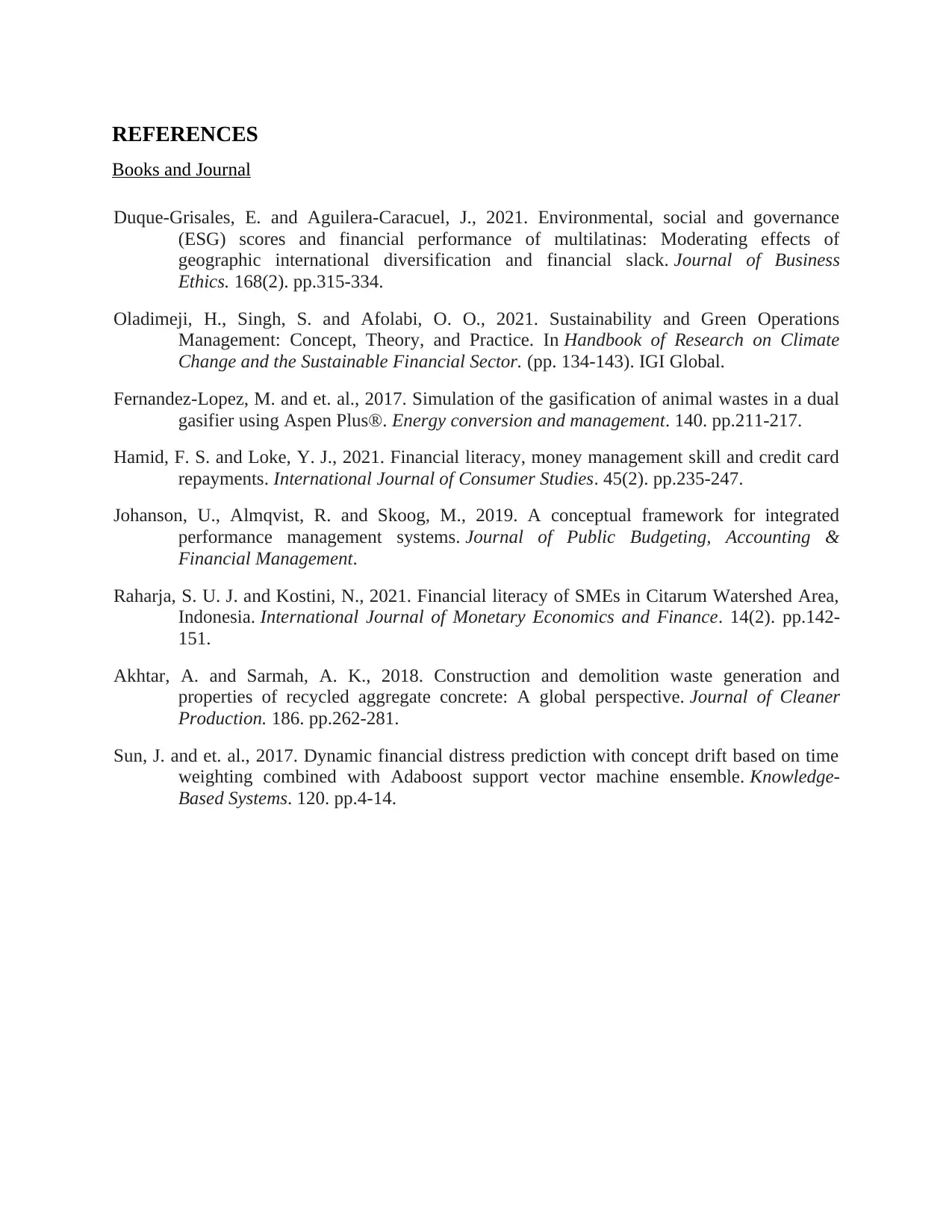
REFERENCES
Books and Journal
Duque-Grisales, E. and Aguilera-Caracuel, J., 2021. Environmental, social and governance
(ESG) scores and financial performance of multilatinas: Moderating effects of
geographic international diversification and financial slack. Journal of Business
Ethics. 168(2). pp.315-334.
Oladimeji, H., Singh, S. and Afolabi, O. O., 2021. Sustainability and Green Operations
Management: Concept, Theory, and Practice. In Handbook of Research on Climate
Change and the Sustainable Financial Sector. (pp. 134-143). IGI Global.
Fernandez-Lopez, M. and et. al., 2017. Simulation of the gasification of animal wastes in a dual
gasifier using Aspen Plus®. Energy conversion and management. 140. pp.211-217.
Hamid, F. S. and Loke, Y. J., 2021. Financial literacy, money management skill and credit card
repayments. International Journal of Consumer Studies. 45(2). pp.235-247.
Johanson, U., Almqvist, R. and Skoog, M., 2019. A conceptual framework for integrated
performance management systems. Journal of Public Budgeting, Accounting &
Financial Management.
Raharja, S. U. J. and Kostini, N., 2021. Financial literacy of SMEs in Citarum Watershed Area,
Indonesia. International Journal of Monetary Economics and Finance. 14(2). pp.142-
151.
Akhtar, A. and Sarmah, A. K., 2018. Construction and demolition waste generation and
properties of recycled aggregate concrete: A global perspective. Journal of Cleaner
Production. 186. pp.262-281.
Sun, J. and et. al., 2017. Dynamic financial distress prediction with concept drift based on time
weighting combined with Adaboost support vector machine ensemble. Knowledge-
Based Systems. 120. pp.4-14.
Books and Journal
Duque-Grisales, E. and Aguilera-Caracuel, J., 2021. Environmental, social and governance
(ESG) scores and financial performance of multilatinas: Moderating effects of
geographic international diversification and financial slack. Journal of Business
Ethics. 168(2). pp.315-334.
Oladimeji, H., Singh, S. and Afolabi, O. O., 2021. Sustainability and Green Operations
Management: Concept, Theory, and Practice. In Handbook of Research on Climate
Change and the Sustainable Financial Sector. (pp. 134-143). IGI Global.
Fernandez-Lopez, M. and et. al., 2017. Simulation of the gasification of animal wastes in a dual
gasifier using Aspen Plus®. Energy conversion and management. 140. pp.211-217.
Hamid, F. S. and Loke, Y. J., 2021. Financial literacy, money management skill and credit card
repayments. International Journal of Consumer Studies. 45(2). pp.235-247.
Johanson, U., Almqvist, R. and Skoog, M., 2019. A conceptual framework for integrated
performance management systems. Journal of Public Budgeting, Accounting &
Financial Management.
Raharja, S. U. J. and Kostini, N., 2021. Financial literacy of SMEs in Citarum Watershed Area,
Indonesia. International Journal of Monetary Economics and Finance. 14(2). pp.142-
151.
Akhtar, A. and Sarmah, A. K., 2018. Construction and demolition waste generation and
properties of recycled aggregate concrete: A global perspective. Journal of Cleaner
Production. 186. pp.262-281.
Sun, J. and et. al., 2017. Dynamic financial distress prediction with concept drift based on time
weighting combined with Adaboost support vector machine ensemble. Knowledge-
Based Systems. 120. pp.4-14.
⊘ This is a preview!⊘
Do you want full access?
Subscribe today to unlock all pages.

Trusted by 1+ million students worldwide
1 out of 13
Related Documents
Your All-in-One AI-Powered Toolkit for Academic Success.
+13062052269
info@desklib.com
Available 24*7 on WhatsApp / Email
![[object Object]](/_next/static/media/star-bottom.7253800d.svg)
Unlock your academic potential
Copyright © 2020–2025 A2Z Services. All Rights Reserved. Developed and managed by ZUCOL.


